Bosch Power Tools PL1682 User Manual
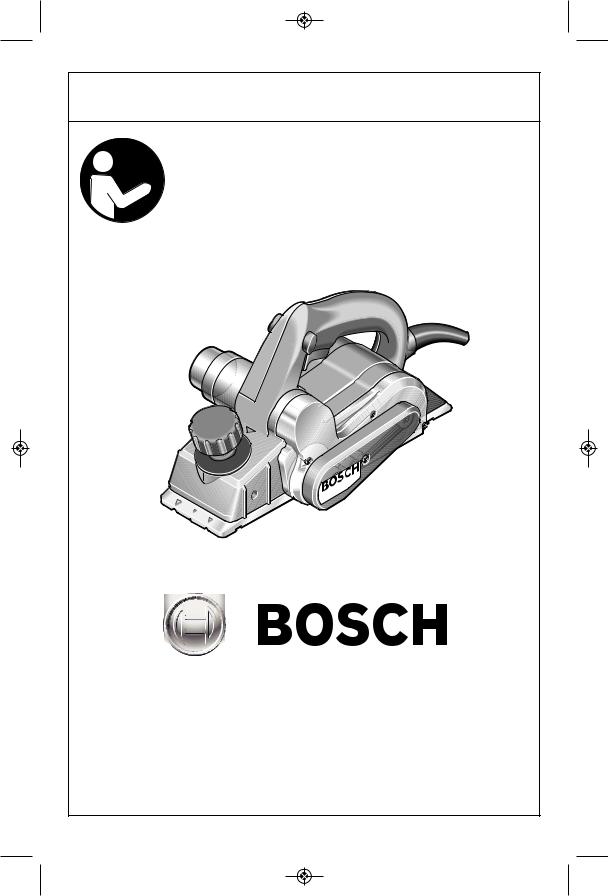
BM 2610021505 02-12_BM 2610021505 02-12.qxp 9/18/12 2:56 PM Page 1
IMPORTANT: |
IMPORTANT : |
IMPORTANTE: |
Read Before Using |
Lire avant usage |
Leer antes de usar |
|
|
|
Operating/Safety Instructions 
 Consignes de fonctionnement/sécurité
Consignes de fonctionnement/sécurité
Instrucciones de funcionamiento y seguridad
PL1682
|
|
|
|
|
|
|
|
Call Toll Free for |
Pour obtenir des informations |
Llame gratis para |
|
||
Consumer Information |
et les adresses de nos centres |
obtener información |
|
|||
|
& Service Locations |
de service après-vente, |
para el consumidor y |
|
||
|
|
|
appelez ce numéro gratuit |
ubicaciones de servicio |
|
|
|
|
|
|
|
||
|
1-877-BOSCH99 (1-877-267-2499) www.boschtools.com |
|
|
|||
|
|
|
|
|
|
|
For English Version |
Version française |
Versión en español |
|
|||
|
See page 2 |
Voir page 14 |
Ver la página 26 |
|
||
|
|
|
|
|
|
|

BM 2610021505 02-12_BM 2610021505 02-12.qxp 9/18/12 2:56 PM Page 2
|
General Power Tool Safety Warnings |
|
Read all safety warnings and all instructions. Failure to follow the warnings |
! WARNING |
|
|
and instructions may result in electric shock, fire and/or serious injury. |
|
SAVE ALL WARNINGS AND INSTRUCTIONS FOR FUTURE REFERENCE
The term “power tool” in the warnings refers to your mains-operated (corded) power tool or battery-operated (cordless) power tool.
Work area safety
Keep work area clean and well lit. Cluttered or dark areas invite accidents.
Do not operate power tools in explosive atmospheres, such as in the presence of flammable liquids, gases or dust. Power tools create sparks which may ignite the dust or fumes.
Keep children and bystanders away while operating a power tool. Distractions can cause you to lose control.
Electrical safety
Power tool plugs must match the outlet. Never modify the plug in any way. Do not use any adapter plugs with earthed (grounded) power tools. Unmodified plugs and matching outlets will reduce risk of electric shock.
Avoid body contact with earthed or grounded surfaces such as pipes, radiators, ranges and refrigerators. There is an increased risk of electric shock if your body is earthed or grounded.
Do not expose power tools to rain or wet conditions. Water entering a power tool will increase the risk of electric shock.
Do not abuse the cord. Never use the cord for carrying, pulling or unplugging the power tool. Keep cord away from heat, oil, sharp edges or moving parts. Damaged or entangled cords increase the risk of electric shock.
When operating a power tool outdoors, use an extension cord suitable for outdoor use. Use of a cord suitable for outdoor use reduces the risk of electric shock.
If operating a power tool in a damp location is unavoidable, use a Ground Fault Circuit Interrupter (GFCI) protected supply. Use of an GFCI reduces the risk of electric shock.
Personal safety
Stay alert, watch what you are doing and use common sense when operating a
power tool. Do not use a power tool while you are tired or under the influence of drugs, alcohol or medication. A moment of inattention while operating power tools may result in serious personal injury.
Use personal protective equipment. Always wear eye protection. Protective equipment such as dust mask, non-skid safety shoes, hard hat, or hearing protection used for appropriate conditions will reduce personal injuries.
Prevent unintentional starting. Ensure the switch is in the off-position before connecting to power source and / or battery pack, picking up or carrying the tool.
Carrying power tools with your finger on the switch or energizing power tools that have the switch on invites accidents.
Remove any adjusting key or wrench before turning the power tool on. A wrench or a key left attached to a rotating part of the power tool may result in personal injury.
Do not overreach. Keep proper footing and balance at all times. This enables better control of the power tool in unexpected situations.
Dress properly. Do not wear loose clothing or jewelry. Keep your hair, clothing and gloves away from moving parts. Loose clothes, jewelry or long hair can be caught in moving parts.
If devices are provided for the connection of dust extraction and collection facilities, ensure these are connected and properly used. Use of dust collection can reduce dustrelated hazards.
Power tool use and care
Do not force the power tool. Use the correct power tool for your application. The correct power tool will do the job better and safer at the rate for which it was designed.
Do not use the power tool if the switch does not turn it on and off. Any power tool that cannot be controlled with the switch is dangerous and must be repaired.
-2-
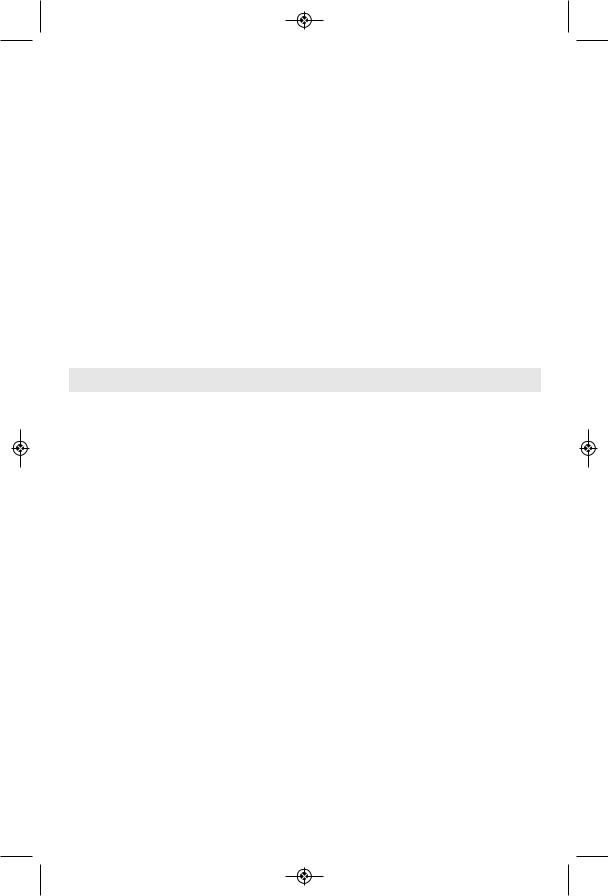
BM 2610021505 02-12_BM 2610021505 02-12.qxp 9/18/12 2:56 PM Page 3
Disconnect the plug from the power source and/or the battery pack from the power tool before making any adjustments, changing accessories, or storing power tools. Such preventive safety measures reduce the risk of starting the power tool accidentally.
Store idle power tools out of the reach of children and do not allow persons unfamiliar with the power tool or these instructions to operate the power tool. Power tools are dangerous in the hands of untrained users.
Maintain power tools. Check for misalignment or binding of moving parts, breakage of parts and any other condition that may affect the power tool’s operation. If damaged, have the power tool repaired before use.
Many accidents are caused by poorly maintained power tools.
Keep cutting tools sharp and clean. Properly maintained cutting tools with sharp cutting edges are less likely to bind and are easier to control.
Use the power tool, accessories and tool bits etc. in accordance with these instructions, taking into account the working conditions and the work to be performed. Use of the power tool for operations different from those intended could result in a hazardous situation.
Service
Have your power tool serviced by a qualified repair person using only identical replacement parts. This will ensure that the safety of the power tool is maintained.
Safety Rules for Planers
Wait for the cutter to stop before setting the tool down. An exposed rotating cutter may engage the surface leading to possible loss of control and serious injury.
Hold the power tool by insulated gripping surfaces only, because the cutter may contact its own cord. Cutting a "live" wire may make exposed metal parts of the tool "live" and could give the operator an electric shock.
Use clamps or another practical way to secure and support the workpiece to a stable platform. Holding the work by hand or against the body leaves it unstable and may lead to loss of control.
Make sure the spring operated automatic retracting rabbet guard returns to blade covering position instantly. The blades are hidden from view and you may be cut if blade is contacted.
Always start the plane before blade is in contact with the workpiece and allow the blade to come to full speed. Tool can vibrate or chatter if blade speed is too slow at beginning of cut and possibly kickback.
Check the workpiece for nails, if there are nails, either remove or set them well
below intended finished surface. If the planer blades strike objects like nails it may cause the tool to kickback and serious personal injury may result.
Unplug the planer before changing accessories. Before plugging the tool in, check that the trigger lock is "OFF".
Accidental start-ups may occur if planer is plugged in while changing an accessory.
After changing blades, rotate the blade drum to make sure blades are not hitting any part of the blade head housing and the blade locking screws are tight.
Spinning blades could strike tool housing and damage tool as well as possible injury.
Always hold the tool firmly with both hands for maximum control.
Never pull the plane backward over the workpiece. Loss of control may occur.
Do not put fingers or any objects into the chip ejector or clean out chips while tool is running. Contact with blade drum will cause injury.
Remove plug from power source if it becomes necessary to remove chips. The blades are hidden from view and you may be cut if blade is contacted.
-3-
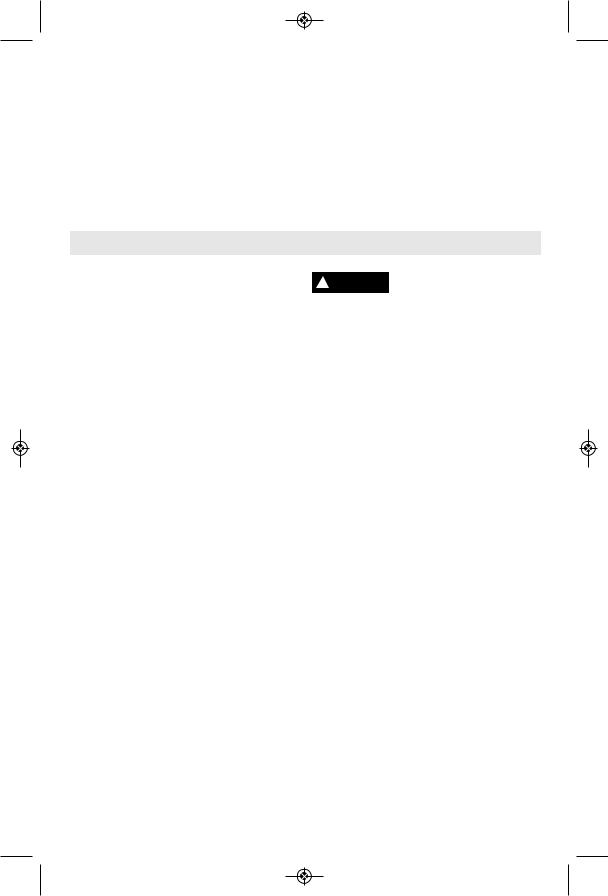
BM 2610021505 02-12_BM 2610021505 02-12.qxp 9/18/12 2:56 PM Page 4
Never use dull or damaged blades. Sharp blades must be handled with care.
Damaged blades can snap during use. Dull
blades require more force to push the tool, possibly causing the blade to break.
Additional Safety Warnings
GFCI and personal protection devices like electrician’s rubber gloves and footwear will further enhance your personal safety.
Do not use AC only rated tools with a DC power supply. While the tool may appear to work, the electrical components of the AC rated tool are likely to fail and create a hazard to the operator.
Keep handles dry, clean and free from oil and grease. Slippery hands cannot safely control the power tool.
Develop a periodic maintenance schedule for your tool. When cleaning a tool be careful not to disassemble any portion of the tool since internal wires may be misplaced or pinched or safety guard return springs may be improperly mounted.
Certain cleaning agents such as gasoline, carbon tetrachloride, ammonia, etc. may damage plastic parts.
Risk of injury to user. The power cord must only be serviced by a Bosch Factory Service Center or Authorized Bosch Service Station.
Some dust created by power sanding, sawing, grinding, drilling, and other construction activities
contains chemicals known to cause cancer, birth defects or other reproductive harm. Some examples of these chemicals are:
•Lead from lead-based paints,
•Crystalline silica from bricks and cement and other masonry products, and
•Arsenic and chromium from chemicallytreated lumber.
Your risk from these exposures varies, depending on how often you do this type of work. To reduce your exposure to these chemicals: work in a well ventilated area, and work with approved safety equipment, such as those dust masks that are specially designed to filter out microscopic particles.
-4-

BM 2610021505 02-12_BM 2610021505 02-12.qxp 9/18/12 2:56 PM Page 5
Symbols
IMPORTANT: Some of the following symbols may be used on your tool. Please study them and learn their meaning. Proper interpretation of these symbols will allow you to operate the tool better and safer.
Symbol |
|
Name |
|
Designation/Explanation |
|||||||
|
|
||||||||||
|
|
|
|
|
|
|
|
|
|
|
|
|
|
|
|
V |
|
Volts |
|
Voltage (potential) |
|||
|
|
|
|
|
|
|
|
|
|
|
|
|
|
|
|
A |
|
Amperes |
|
Current |
|||
|
|
|
|
|
|
|
|
|
|
|
|
|
|
Hz |
|
Hertz |
|
Frequency (cycles per second) |
|||||
|
|
|
|
|
|
|
|
|
|
|
|
|
|
|
W |
|
Watt |
|
Power |
||||
|
|
|
|
|
|
|
|
|
|
|
|
|
|
|
kg |
|
Kilograms |
|
Weight |
||||
|
|
|
|
|
|
|
|
|
|
|
|
|
min |
|
Minutes |
|
Time |
||||||
|
|
|
|
|
|
|
|
|
|
|
|
|
|
|
|
s |
|
Seconds |
|
Time |
|||
|
|
|
|
|
|
|
|
|
|
|
|
|
|
|
|
|
|
|
|
|
Diameter |
|
Size of drill bits, grinding wheels, etc. |
|
|
|
|
|
|
|
|
|
|
|
|
|
|
|
n0 |
|
No load speed |
|
Rotational speed, at no load |
||||
|
|
|
|
n |
|
Rated speed |
|
Maximum attainable speed |
|||
|
|
|
|
|
|
|
|
|
|
|
|
.../min |
|
Revolutions or reciprocation |
|
Revolutions, strokes, surface speed, |
|||||||
|
|
|
|
|
|
|
|
|
per minute |
|
orbits etc. per minute |
|
|
|
|
|
|
|
|
|
|
|
|
0 |
|
|
|
Off position |
|
Zero speed, zero torque... |
|||||
|
|
|
|
|
|
|
|
|
|
|
|
1, 2, 3, ... |
|
Selector settings |
|
Speed, torque or position settings. |
|||||||
I, II, III, |
|
|
|
Higher number means greater speed |
|||||||
|
|
|
|
|
|
|
|
|
|
|
|
0 |
|
|
|
|
|
|
Infinitely variable selector with off |
|
Speed is increasing from 0 setting |
||
|
|
|
|
|
|
|
|
|
|
|
|
|
|
|
|
|
|
|
|
|
Arrow |
|
Action in the direction of arrow |
|
|
|
|
|
|
|
|
|
|||
|
|
|
|
|
|
|
|
|
|
|
|
|
|
|
|
|
|
|
|
|
Alternating current |
|
Type or a characteristic of current |
|
|
|
|
|
|
|
|
|
|
|
|
|
|
|
|
|
|
|
|
|
Direct current |
|
Type or a characteristic of current |
|
|
|
|
|
|
|
|
|
|||
|
|
|
|
|
|
|
|
|
|
|
|
|
|
|
|
|
|
|
|
|
Alternating or direct current |
|
Type or a characteristic of current |
|
|
|
|
|
|
|
|
|
|||
|
|
|
|
|
|
|
|
|
|
|
|
|
|
|
|
|
|
|
|
|
Class II construction |
|
Designates Double Insulated |
|
|
|
|
|
|
|
|
|
|||
|
|
|
|
|
|
|
|
|
|
|
Construction tools. |
|
|
|
|
|
|
|
|
|
|
|
|
|
|
|
|
|
|
|
|
|
|
|
|
|
|
|
|
|
|
|
|
|
Earthing terminal |
|
Grounding terminal |
|
|
|
|
|
|
|
|
|
|||
|
|
|
|
|
|
|
|
|
|
|
|
|
|
|
|
|
|
|
|
|
Warning symbol |
|
Alerts user to warning messages |
|
|
|
|
|
|
|
|
|
|
|
|
|
|
|
|
|
|
|
|
|
|
|
|
|
|
|
|
|
|
|
|
|
Li-ion RBRC seal |
|
Designates Li-ion battery recycling |
|
|
|
|
|
|
|
|
|
|
|
program |
|
|
|
|
|
|
|
|
|
|
|
|
|
|
|
|
|
|
|
|
|
Ni-Cad RBRC seal |
|
Designates Ni-Cad battery recycling |
|
|
|
|
|
|
|
|
|
|
|
program |
|
|
|
|
|
|
|
|
|
|
|
|
|
|
|
|
|
|
|
|
|
Read manual symbol |
|
Alerts user to read manual |
|
|
|
|
|
|
|
|
|
|
|
|
|
|
|
|
|
|
|
|
|
Wear eye protection symbol |
|
Alerts user to wear eye protection |
|
|
|
|
|
|
|
|
|
|
|
|
-5-

BM 2610021505 02-12_BM 2610021505 02-12.qxp 9/18/12 2:56 PM Page 6
Symbols (continued)
IMPORTANT: Some of the following symbols may be used on your tool. Please study them and learn their meaning. Proper interpretation of these symbols will allow you to operate the tool better and safer.
This symbol designates that this tool is listed by Underwriters Laboratories.
This symbol designates that this tool is recognized by Underwriters Laboratories.
This symbol designates that this tool is listed by Underwriters Laboratories, to United States and Canadian Standards.
This symbol designates that this tool is listed by the Canadian Standards Association.
This symbol designates that this tool is listed by the Canadian Standards
Association, to United States and Canadian Standards.
This symbol designates that this tool is listed by the Intertek Testing
Services, to United States and Canadian Standards.
This symbol designates that this tool complies to NOM Mexican Standards.
-6-
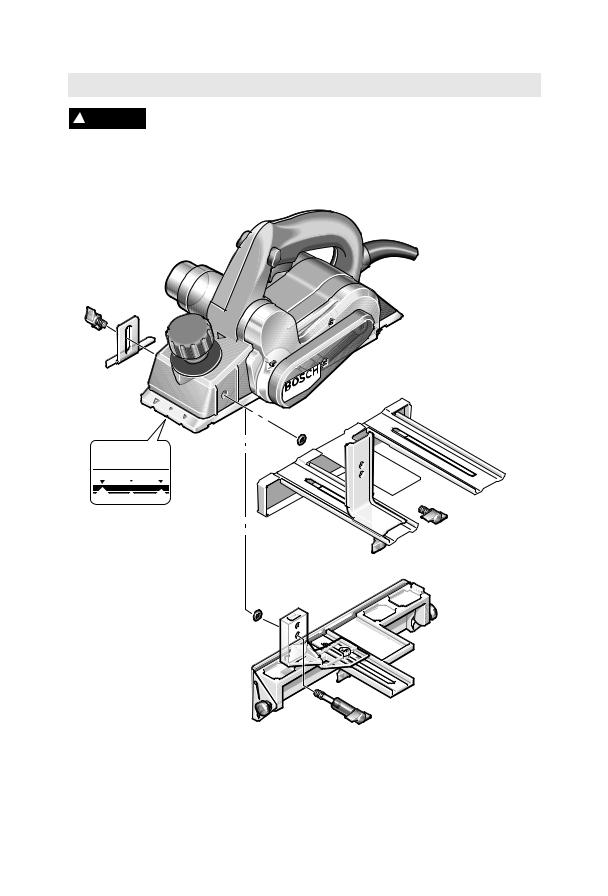
BM 2610021505 02-12_BM 2610021505 02-12.qxp 9/18/12 2:56 PM Page 7
Functional Description and Specifications
Disconnect the plug from the power source before making any assembly, adjustments or changing accessories. Such preventive safety
measures reduce the risk of starting the tool accidentally.
Planer
“LOCK-OFF”
BUTTON
|
FIG. 1 |
|
CHIP |
DEPTH |
|
ADJUSTMENT |
||
EXHAUST |
||
KNOB |
||
PORT |
||
|
||
RABBETING |
TRIGGER SWITCH |
|
|
||
DEPTH STOP |
PARK REST STAND |
|
(OPTIONAL) |
||
|
BLADE WRENCH STORAGE |
|
|
DRIVE BELT COVER |
WING |
|
SCREW |
|
|
|
KNOB |
|
|
|
|
GUIDE |
ADJUSTABLE |
|
BRACKET |
FRONT SHOE |
|
|
CHAMFER |
DEPTH |
|
V-GROOVE |
|
|
SCALE |
|
|
|
|
|
|
|
STANDARD |
|
|
GUIDE |
|
|
FENCE |
|
FENCE |
WING |
|
|
KNOB |
|
|
WING |
|
|
KNOB |
|
GUIDE |
DELUXE |
|
BRACKET |
GUIDE |
|
|
FENCE |
Note: Each unlabeled |
PIVOT |
(OPTIONAL) |
mark represents |
FENCE |
WIDTH |
0.5 mm. |
ROUND |
SCALE |
|
|
|
|
KNOB |
WING KNOB |
|
|
Maximum Capacities |
|
|
Planing depth |
0 |
- 1/16" (0 - 1.5mm) |
Rabbeting depth |
0 |
- 5/16" (0 - 9mm) |
Planing width |
3-1/4" (82mm) |
|
NOTE: For tool specifications refer to the nameplate on your tool.
-7-

BM 2610021505 02-12_BM 2610021505 02-12.qxp 9/18/12 2:56 PM Page 8
Assembly
CHIP ExTRACTION
The planer chip exhaust port may be used with a chip bag (Fig. 2) or a shop vacuum and vacuum connector (Fig. 3) to keep your work environment cleaner.
Bosch offers several different vacuum hoses that will connect directly to this tool. The optional VAC002 adapter will connect the hood to 1-1/4” and 1-1/2” vacuum hoses. The VAC020 connects the hood to 2-1/2" hoses and is also available separately.
UNCLOGGING THE CHIP ExHAUST SYSTEM Remove plug from power source if it becomes
FIG. 2
necessary to manually remove chips. The blades are hidden from view and you may be cut if contacted.
To minimize the possibility of clogging, make sure:
1.The depth of cut is reasonable for the material.
2.The feed rate is reasonable for the material. (See FEED RATE & DEPTH OF CUT)
3.Unplug the planer and carefully insert a screwdriver or similar object into the dust port to break up the clog.
FIG. 3
|
VACUUM |
EXHAUST |
HOSE ADAPTER |
PORT |
(OPTIONAL) |
PLANER BLADES
The planer blades are sharp ! WARNING and fragile and must be
handled carefully to avoid injury to the user or damage to the blades.
The PA1202 planer blades have two cutting edges, and may be reversed when one of the cutting edges becomes dull or chipped.
Do not attempt to sharpen or use resharpened used blades of any kind. Use only blades designated for use with this model, because other blades will cause vibration, decrease perfomance and may not clamp securely in blade holder.
REVERSING OR REPLACING BLADES
To reverse or replace the blade, loosen the clamping screws with blade wrench. With the screws loosened, slide the blade lengthwise out of the cutter drum, taking care to keep your fingers away from the sharp edges of the blade (Fig. 4).
A piece of wood may be used for this purpose. If the blade is gummed and difficult to remove, you may clean the blade with mineral spirits, lacquer thinner or alcohol.
Clean all surfaces before reinstalling the new blade, as this will ensure an accurate blade setting and proper tool performance.
FIG. 4 |
2.5 MM |
|
BLADE |
|
WRENCH |
BLADE
CUTTER
DRUM
CLAMPING
SCREW
-8-
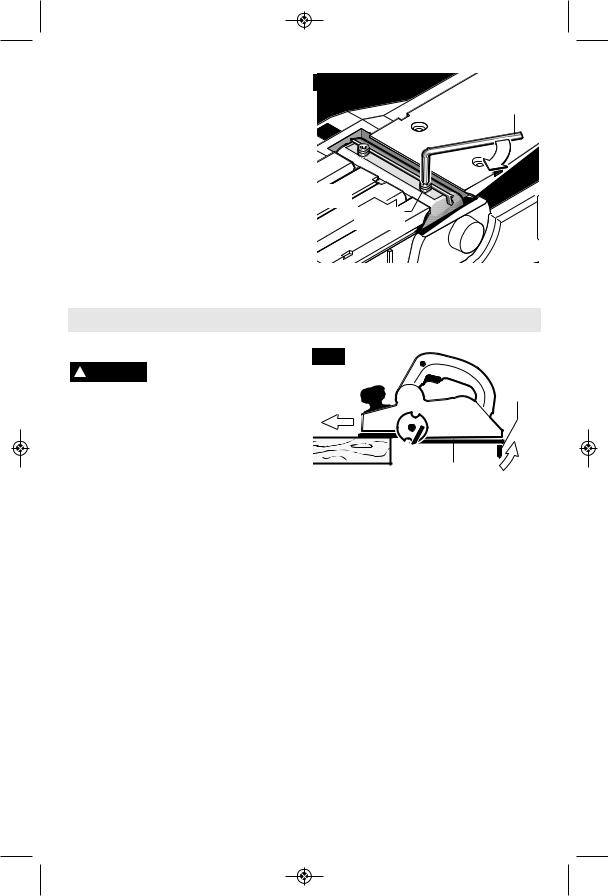
BM 2610021505 02-12_BM 2610021505 02-12.qxp 9/18/12 2:56 PM Page 9
BLADE ALIGNMENT
The blade should be centered relative to the front and rear shoes. (Fig 5.) Rotate the blade drum by hand to verify sure that the blade doesn’t touch to any other part of the tool.
Make sure the blade sits correctly in the holder groove of the cutter drum.
You may then tighten the clamping screws which secure the blade and your planer is ready for use.
FIG. 5 |
2.5 MM |
|
BLADE |
|
WRENCH |
CUTTER
DRUM
CLAMPING
SCREW
Operating Instructions
TRIGGER "ON/OFF" SWITCH
Hold the tool with both ! WARNING hands while starting the
tool, since torque from the motor can cause the tool to twist.
To turn tool "ON": depress the “Lock-Off” release button from either side and squeeze the trigger switch.
To turn the tool "OFF": release the trigger switch and it will return to "OFF" position automatically.
To increase switch life, do not turn switch on and off while tool and drum are held against a workpiece.
PLANING ACTION
Proper planing action helps to achieve the desired result. With practice and experience, it will become second nature. Make sure that the workpiece is held in place securely on your work surface, and standing comfortably, hold the planer firmly with both hands.
1.With the planer fully adjusted, place the front shoe on the workpiece, (be certain that the blade drum is not in contact with the work) and start the planer as described earlier.
2.With pressure on the front shoe, and the fence against the side of the work (to control the width or angle,) feed the planer steadily until the full length of the rear shoe passes over the edge of the workpiece. (Fig. 6)
3.Then gradually transfer pressure to the rear shoe, and continue planing to the end of the cut.
FIG. 6
PARK
REST
SHOE
4.If pressure is not maintained over the rear shoe through the end of the cut, a divot may be created in the workpiece once the front shoe clear the end of the workpiece. To minimize this possibility, use a 3-way edge clamp to hold a piece of scrap wood (at least 1-1/2" (38 mm) thick) on the end of the workpiece, aligned with the surface to be planed. Doing this moves the location of a potential divot off the workpiece and on to the piece of scrap wood.
5.Feed the planer at a uniform and reasonable rate that does not put excessive strain on the motor or blades, (do not pull the planer back over the surface already cut.)
6.Use progressive cuts until you are near the desired depth, and then re-adjust to a thin cut for the final pass to obtain a good surface finish.
! |
CAUTION |
The motor may stall if |
improperly used or |
||
|
|
|
overloaded. Reduce the pressure (feed rate) or depth of cut to prevent possible damage to the tool if the motor labors.
-9-
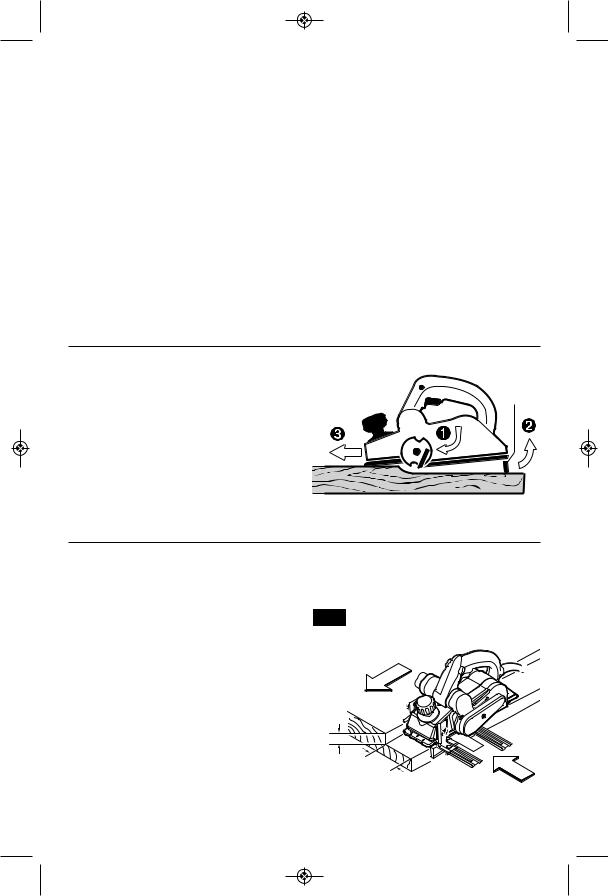
BM 2610021505 02-12_BM 2610021505 02-12.qxp 9/18/12 2:56 PM Page 10
DEPTH OF CUT & FEED RATE
The cutting depth (planing depth) is determined by the difference in height between the adjustable front shoe and the fixed rear shoe of the planer. The depth knob adjusts the front shoe, which retracts and exposes the blade and determines the amount of material removed from the workpiece. The cutting depth range is from 0 to 1/16" (1.5 mm) per pass. (Fig. 1)
The appropriate depth of cut and feed rate depends on the workpiece material:
To avoid clogging and/or damage to the motor, a more (thin) cut and/or a slower feed rate may be needed if the material has any of these characteristics: hardness; gumminess, sappiness, moisture, paint, varnish and/or knots. Also, when planing against the grain or across the grain rather than with the grain, a
shallower cut and/or slower feed rate is required. Whenever possible, test by planing a similar piece of scrap material.
Use multiple, progressive cuts to achieve the total desired depth.
Start with a thin cut. If the plane moves freely through the workpiece with no excessive load on the motor, the depth setting can be increased before the next cut. (Do not change depth of cut while planing.)
When near the desired total depth, re-adjust the planing depth to a thin setting for the final cut to obtain a good surface finish.
Adjusting the Depth of Cut: Rotate depth adjustment knob clockwise until the indicator is aligned with the desired cutting depth on the depth scale (Fig. 1).
PARK REST STAND |
|
FIG. 7 |
|
The park rest stand automatically springs |
|
|
|
down to help keep the blade from coming in |
|
contact with the work surface when planer is |
|
not in use (Fig. 7). The park rest stand is |
|
designed to swing up and out of the way by it |
|
itself when the back of the plane crosses the |
|
leading edge of the workpiece (Fig. 6). It will |
|
also swing up when planing begins in the |
|
middle of the work piece (in from the edge of |
|
the work piece). |
|
PARK REST
STANDARD GUIDE FENCE
The guide fence can be used to control the width of the cut or for simply providing added stability and protection when cutting materials that are up to 3-1/4" wide.
Note: When used for rabbeting, the fence must be attached to the left side of the tool. (Fig. 1).
Installing the guide fence: Place the wing knob through the appropriate hole in the guide bracket and screw into preferred side of the housing. Securely tighten wing knob. Setting the cutting width: Place wing knob through the appropriate fence arm and slide along the guide bracket to the desired position. Securely tighten wing knob. Be certain that the flat washer (supplied) is fitted between the bottom
of the guide fence and wing knob or the guide fence is likely to slip.
FIG. 8
9 mm max
82 |
mm |
|
|
max |
|
-10-
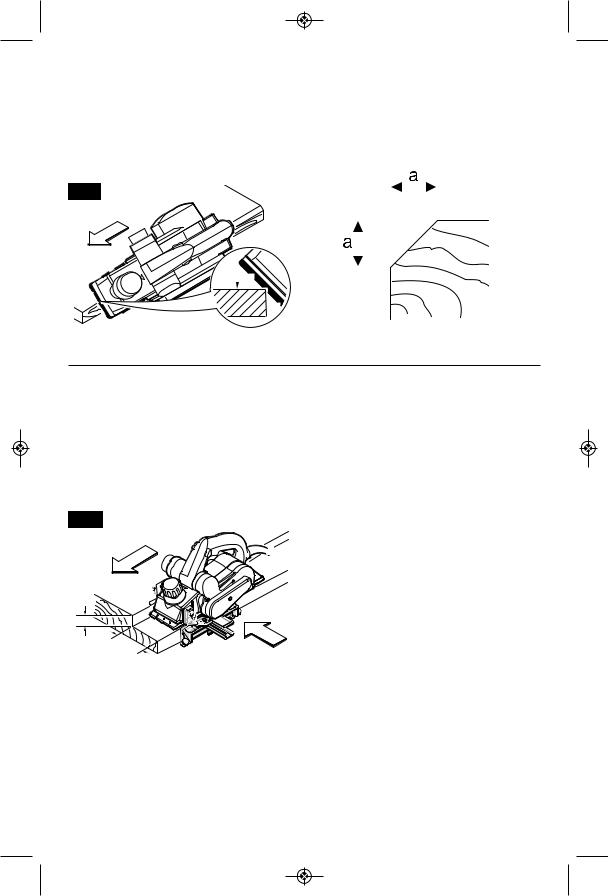
BM 2610021505 02-12_BM 2610021505 02-12.qxp 9/18/12 2:56 PM Page 11
BEVELING EDGES
The V-grooves in the front planer base plate allow quick and easy beveling of workpiece edges.
Depending on required bevel width, use the corresponding V-groove. For this, place the planer with the V-groove onto the edge of the workpiece and guide it along the edge (Fig. 9).
FIG. 9
45° 
Groove to be used |
Dimension a (mm) |
||||||
|
None |
|
0 – 4 |
||||
|
Small |
|
2 – 6 |
||||
Medium |
|
4 – 9 |
|||||
|
Large |
|
6 – 10 |
||||
|
|
|
|
|
|
|
|
|
|
|
|
|
|
|
|
|
|
|
|
|
|
|
|
|
|
|
|
|
|
|
|
|
|
|
|
|
|
|
|
|
|
|
|
|
|
|
|
|
|
|
|
|
|
|
|
DELUxE GUIDE FENCE
The deluxe guide fence can be used to control the width of the cut or for simply providing added stability and protection when cutting materials that are up to 3-1/4" wide, with the additional capability of guiding the planer on any angle up to 45 degrees, to allow edge chamfering and beveling (Fig. 9).
FIG. 10
9 mm max
82 |
m |
|
||
m |
|
m |
||
ax |
||||
|
|
|||
Note: The deluxe fence must be attached to the left side of the tool. (Fig. 1).
Installing the deluxe guide fence: Place the wing knob through the appropriate hole in the guide bracket and screw into left side of the housing. Securely tighten wing knob. Setting the cutting width: Place wing knob through the left fence arm and slide along the guide bracket to the desired position. Securely
tighten wing knob. Be certain that the flat washer (supplied) is fitted between the bottom of the guide fence and wing knob or the guide fence is likely to slip.
Setting the cutting width: Loosen wing knob and using the width scale, slide the fence along the guide bracket to the desired position. Securely tighten wing knob (Fig. 1).
Setting the cutting angle: Loosen round knobs and pivot the fence to the desired position. Securely tighten round knobs (Fig. 1).
Note that the adjustable front shoe contains three chamfer V-grooves, which will follow the corner of a workpiece to allow easier handling when using the deluxe angle/width fence (Fig. 9).
RABBETING DEPTH STOP
The optional rabbeting depth stop accessory (Fig. 1) allows the user to set any rabbeting depth from 0 to 5/16" (9 mm). For best results, it is important that the blade be properly aligned (See "BLADE ALIGNMENT"). The width of the rabbet is controlled by the width fence. The final depth is achieved by repetitive cutting until the rabbeting depth guide contacts the workpiece. The maximum rabbeting depth is 5/16" (9 mm).
Setting the rabbet depth: Loosen wing knob and using the depth scale on the rabbeting depth stop, set the desired rabbet depth. Securely tighten wing knob (Fig. 1).
-11-
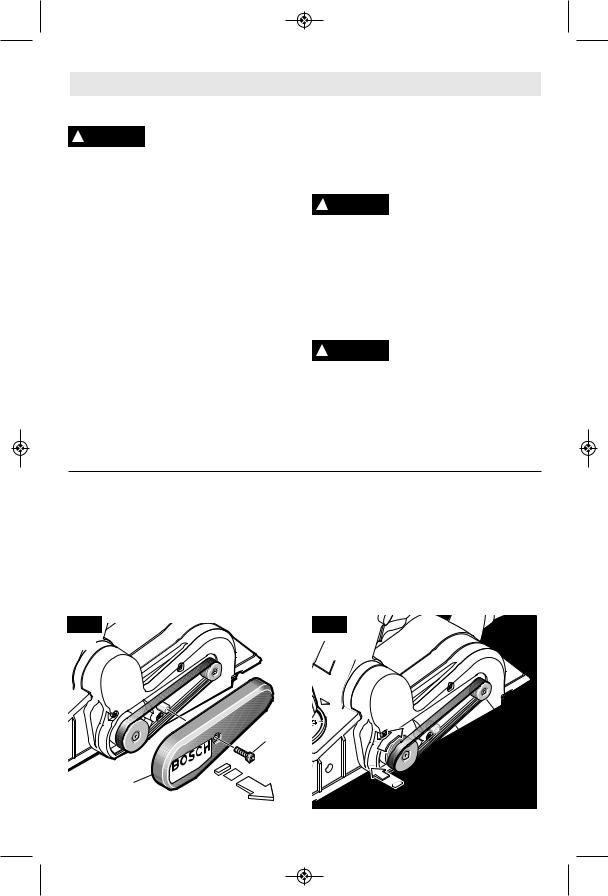
BM 2610021505 02-12_BM 2610021505 02-12.qxp 9/18/12 2:56 PM Page 12
Maintenance
Service
Preventive maintenance ! WARNING performed by unauthorized personnel may result in misplacing of internal wires and components which could cause serious hazard. We recommend that all tool service be performed by a Bosch Factory Service Center or Autho-
rized Bosch Service Station.
TOOL LUBRICATION
Your Bosch tool has been properly lubricated and is ready to use. It is recommended that tools with gears be regreased with a special gear lubricant at every brush change.
CARBON BRUSHES
The brushes and commutator in your tool have been engineered for many hours of dependable service. To maintain peak efficiency of the motor, we recommend every two to six months the brushes be examined. Only genuine Bosch replacement brushes specially designed for your tool should be used.
BEARINGS
Bearings which become noisy (due to heavy load or very abrasive material cutting) should be replaced at once to avoid overheating or motor failure.
Cleaning
To avoid accidents always disconnect the tool from the power supply before cleaning or
performing any maintenance. The tool may be cleaned most effectively with compressed dry air. Always wear safety goggles when cleaning tools with compressed air.
Ventilation openings and switch levers must be kept clean and free of foreign matter. Do not attempt to clean by inserting pointed objects through openings.
Certain cleaning agents ! CAUTION and solvents damage
plastic parts. Some of these are: gasoline, carbon tetrachloride, chlorinated cleaning solvents, ammonia and household detergents that contain ammonia.
Clean the park rest shoe regularly and ensure that it springs back freely.
DRIVE BELT |
Installing new drive belt: Loosen screw and |
The drive belt is a normal maintenance part |
remove the drive belt cover (Fig. 11). Cut and |
and should be inspected periodically for wear. |
remove the worn drive belt. Before installing the |
If the drive belt shows signs of drying out, |
new drive belt, clean both pulleys thoroughly. |
cracking or tearing, it should be replaced. If the |
First place the new drive belt onto the drive |
drive belt will not track properly or comes off |
pulley then rotate clockwise while pushing the |
the pulleys, it should be replaced. |
belt onto the driven pulley (Fig. 12). Reinstall |
|
the drive belt cover and securely tighten screw |
|
(Fig. 11). |
FIG. 11 |
FIG. 12 |
SCREW |
DRIVEN |
PULLEY |
DRIVE
BELT
DRIVE BELT 


 COVER DRIVE
COVER DRIVE
PULLEY
-12-
